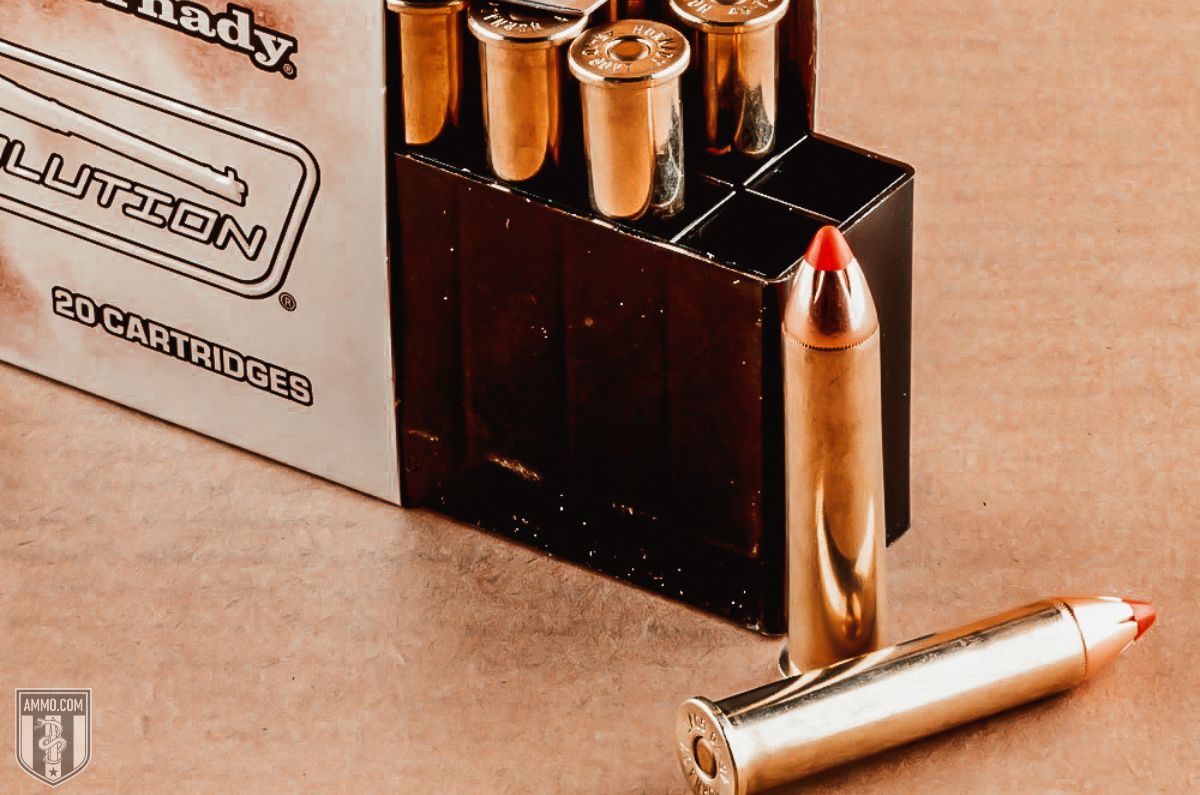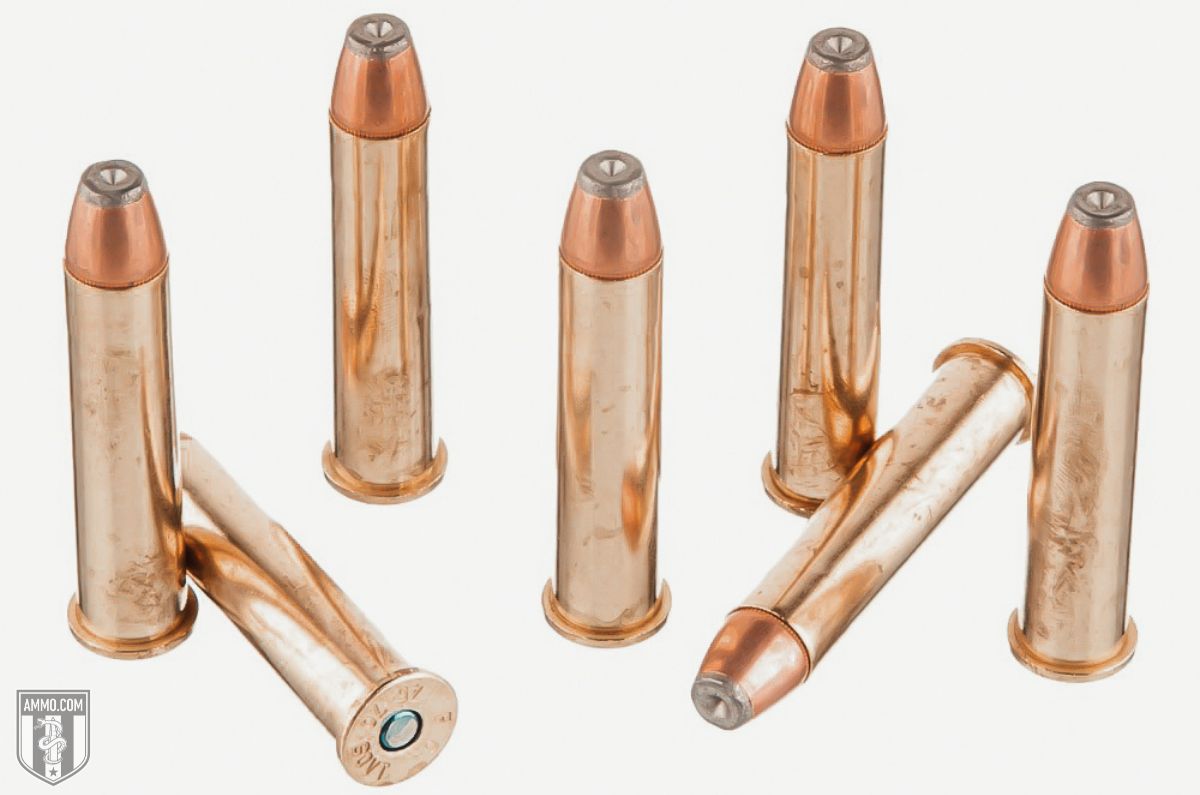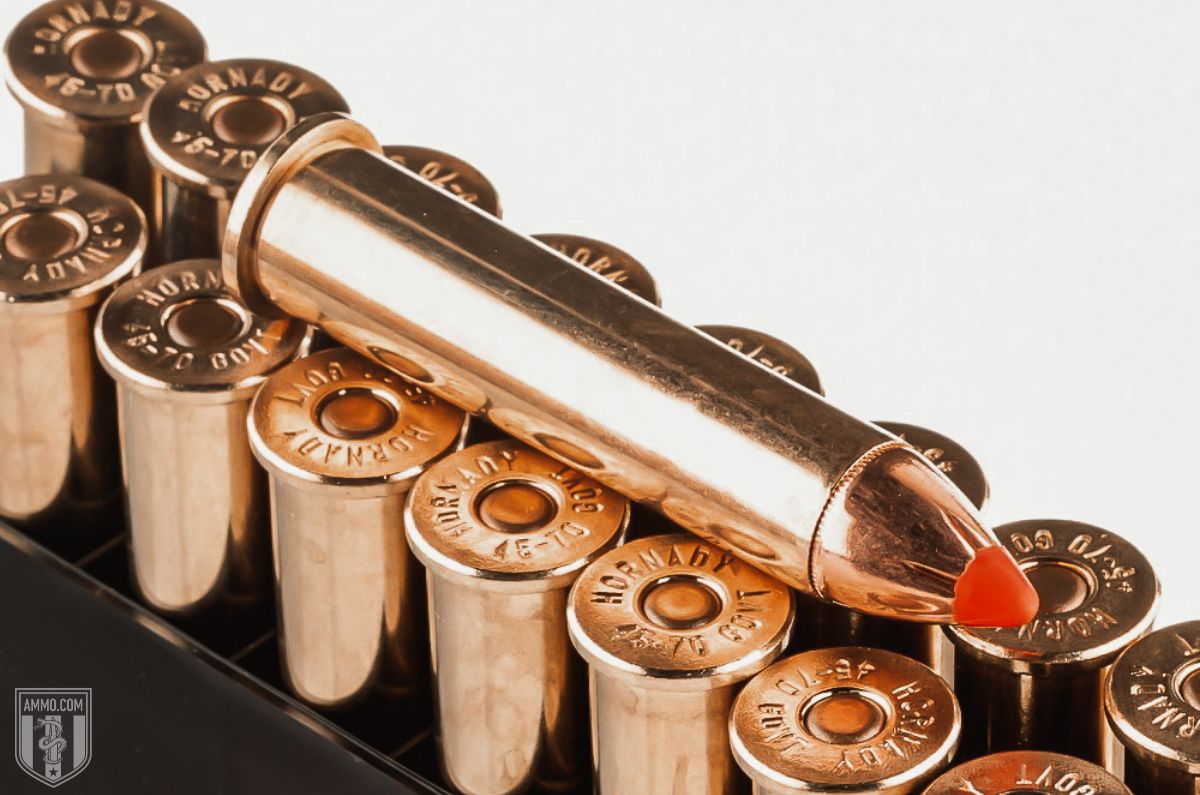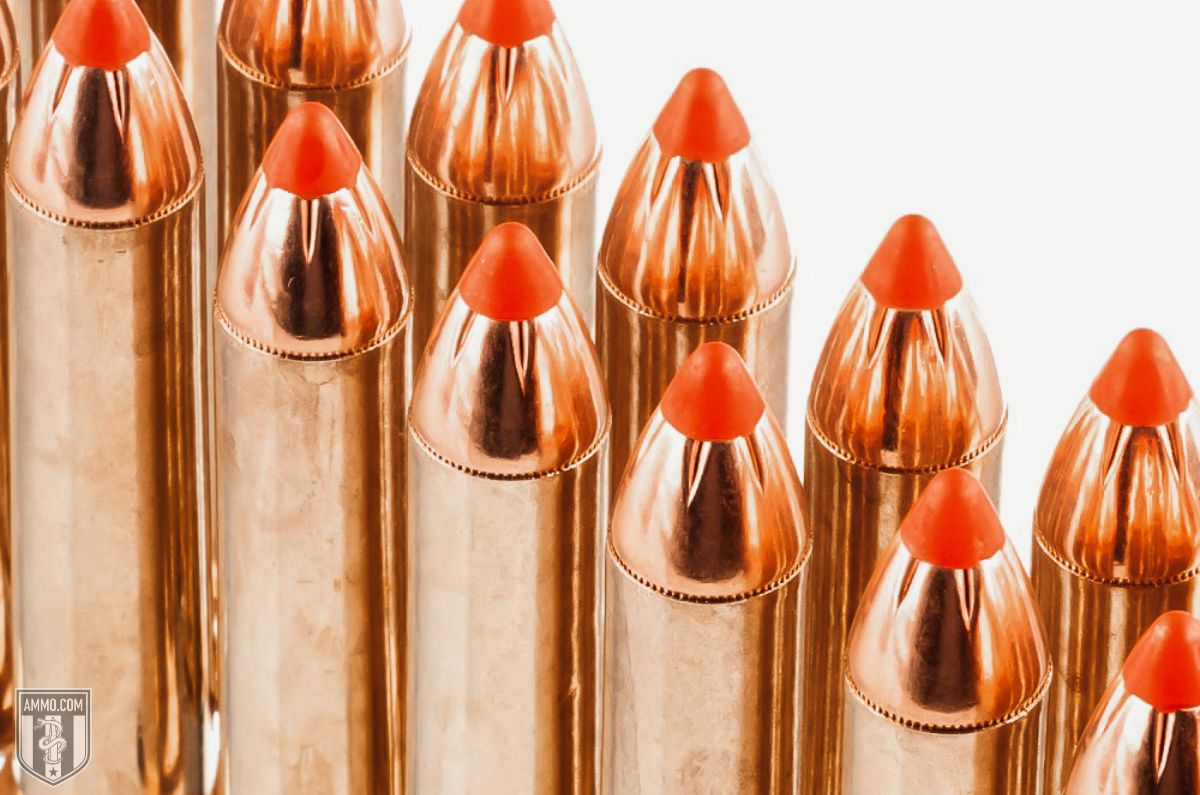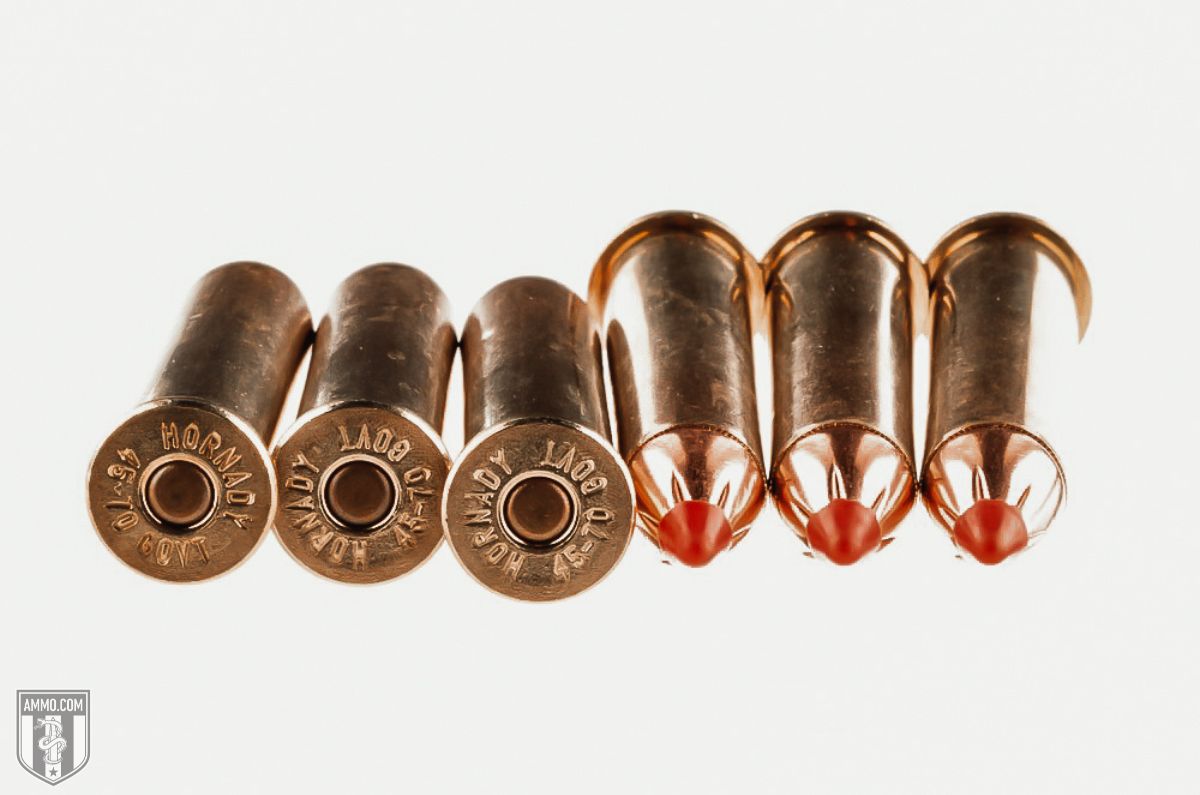458 SOCOM vs 45 70: Big Bore AR or Lever Gun?
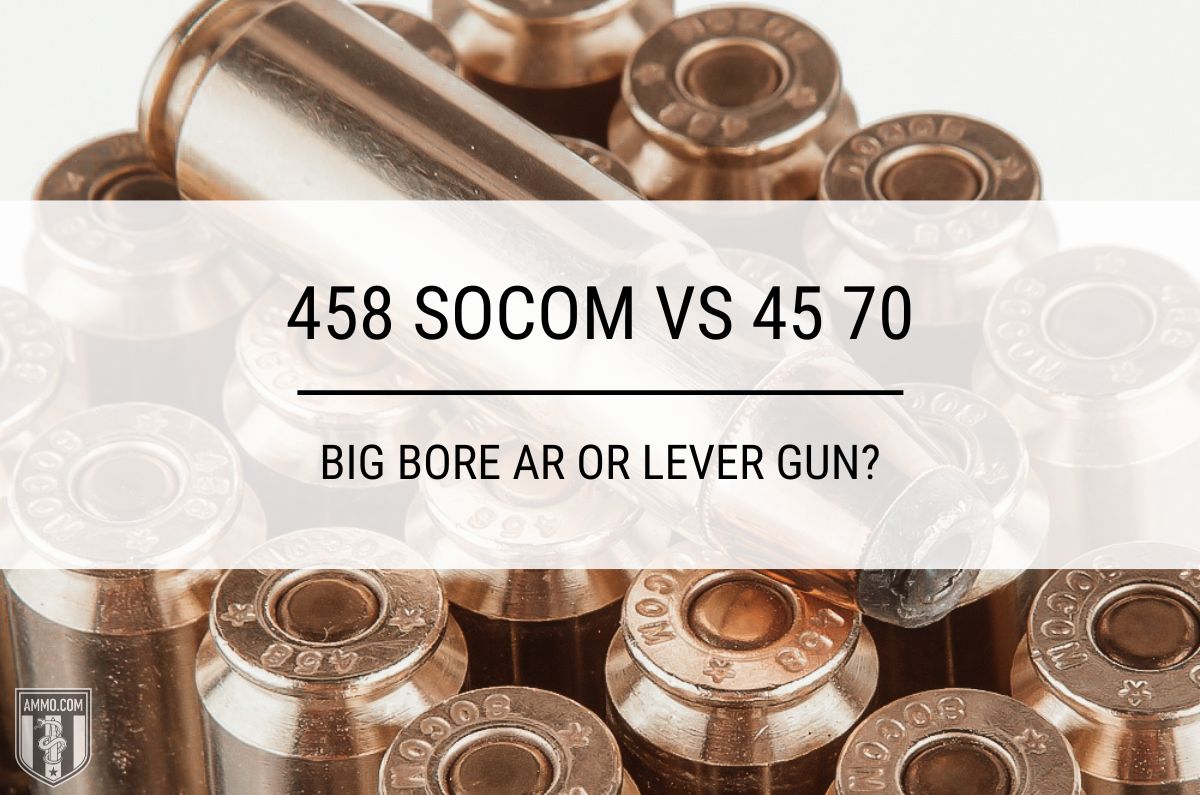
Make no mistake, the 458 SOCOM and 45-70 Government are two centerfire rifle cartridges that understand the meaning of “stopping power”.
Firing a massive 0.458” diameter bullet, both rounds are more than adequate for taking down a herd of feral hogs, deer hunting in the back woods, and stalking the majestic plains buffalo.
Although the development of these rounds was separated by over 125 years, the 458 SOCOM and 45-70 Government (Govt for short) are incredibly similar in terms of ballistics and the deciding between them primarily comes down to your preferred hunting rifle.
For lever-action rifle lovers the 45 70 is gold standard for big game, while the 458 SOCOM is an excellent choice for those hunters who want a big bore AR-15.
In this article, we will evaluate the 458 SOCOM vs 45 70 Government to help you understand the differences between the two and give you a clearer idea of which cartridge is best for your shooting and big game hunting needs.
What is the difference between the 458 SOCOM and the 45 70?
The biggest difference between the 458 SOCOM and 45 70 Govt is the rifle used for each cartridge. The 45-70 is primarily a lever-action cartridge while the 458 SOCOM is chambered in the AR platform.
Cartridge Specs
When evaluating centerfire cartridges, it’s a good idea to analyze the cartridge specs to gain more knowledge of each.
Perhaps the biggest difference between these two cartridges is the time period when they were developed. The 45 70 was released shortly after the end of the American Civil War in the early 1870’s while the 458 SOCOM was developed in 2000 and released in 2001.
The 45-70 Government was initially a black powder cartridge that utilized a significantly different naming system than modern cartridges that can be confusing to new shooters.
The original name for the 45-70 Govt was 45-70-405 and here’s what that means:
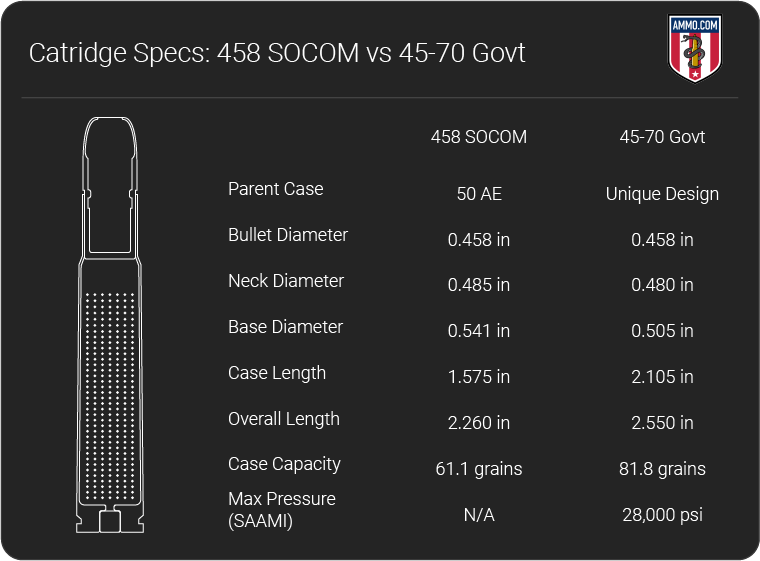
- 45: The cartridge fires a 0.458” diameter bullet
- 70: The powder charge is 70 grains of black powder
- 405: The bullet weight is 405 grains
The .45-70 was developed by the U.S. Army’s Springfield Armory for their new single shot Model 1873 rifle which came to be known as the “Trapdoor Springfield”.
The 45-70 has no parent case and was a completely unique design.
On the other hand, development of the 458 SOCOM began in 2000 in response to a conversation (supposedly at a barbecue) between Marty Ter Weeme of Teppo Jutsu LLC and a member of the United States Special Operations Command (SOCOM) surrounding the ineffectiveness of the 5.56 NATO round in the Battle of Mogadishu.
Instead of using a unique case design, a 50 Action Express (50 AE) was lengthened to 1.575” and given a slight shoulder for the 458. The 50 AE is most well-known for being the primary chambering of the Desert Eagle handgun.
The 458 SOCOM is part of a classification of AR-15 rounds known as the Thumper Concept. The term was coined by American shooting icon Lt. Col. Jeff Cooper as he envisioned rounds that were 45-caliber or larger and capable of taking down a whitetail in a single shot.
The three most popular Thumper Rounds are the 450 Bushmaster, 458 SOCOM, and 50 Beowulf. To read more about these three rounds, check out this article: 450 Bushmaster vs 458 SOCOM vs 50 Beowulf.
When looking at the cases for the 45-70 and the 458, the 45-70 utilized an older straight-walled cartridge designed for a lever gun. On the other hand, the 458 SOCOM utilizes the more modern bottle-necked cartridge case for improved feeding reliability in a semi-auto AR-15.
The 45-70 case is considerably longer than the 458, with a case length of 2.105” for the 45-70 Govt and 1.575” for the 458. Overall length is also extremely different, with 2.55” maximum overall length for the 45 70 compared to 2.26” for the SOCOM round.
With a larger case comes increased case capacity. A larger case was needed for the 45-70 for its heavy charge of black powder. However, with the advent of smokeless powder, smaller powder charges were needed.
Although rarely filled to capacity, the 45-70 can hold 81.8 grains while the 458 SOCOM has a case capacity of 61.1 grains.
Another major difference is that the 45-70 is a rimmed cartridge while the 458 is rimless. Rimmed cartridges are often used by lever guns as a solid point of contact for the extractor to ensure solid feeding and extraction into and out of the chamber.
The 458 uses a rebated rim design, meaning their rim is narrower than their cartridge base. The 458 has a rim diameter of 0.473”, which is the same as the 308 Winchester, 30-06 Springfield, and 270 Win.
Although the cartridge cases of both rounds are very different, they both fire the same 0.458” diameter bullets. This allows both rifle cartridges to fire extremely heavy projectiles with bullet weights ranging from 250 grains up to 500 grains for the 45-70. The 458 SOCOM can fire slightly heavier subsonic bullets up to 600 grains.
The most popular 45-70 factory ammo is typically loaded with 325 gr, 350 gr, 405 gr, and 500 grain bullets while 250 gr, 300 gr, and 350 gr are the most popular for 458.
The final difference between the 45 70 and 458 is their maximum chamber pressure as established by SAAMI. The 45-70 is a relatively low-pressure round by modern standards with a maximum pressure of 28,000 psi per SAAMI specs.
The 458 is not currently a SAAMI certified cartridge, so it does not have an established max pressure. Handloaders typically keep reloads below 35,000 PSI for the 458 but this number should not be considered a published maximum and you should always follow published load data when reloading for any cartridge.

Recoil
Recoil is an important consideration when purchasing a new rifle as a round with heavy recoil will be more difficult to control and will slow your rate of follow up shots. The potential for flinching is also an issue for cartridges with heavy recoil.
Felt recoil will differ from shooter to shooter and is often dependent on firearm choice, stance, and your chosen factory ammo or handloads. However, free recoil is a more objective measure of how hard a cartridge hits based on firearm weight, muzzle velocity, powder charge, and bullet weight.
There’s no denying that these big bore cartridges have heavy recoil. With massive powder charges and heavy bullets, both cartridges can be a challenge to control for new shooters.
One aspect that is more unique to the 45-70 is the type of load you plan on firing. Due to is gaping case capacity, there are a wide variety of factory loads for a shooter to choose from.
Which 45-70 load you pick will depend primarily on the rifle you plan on using, as newer production rifles like the Marlin 1895 Guide Gun can handle a lot more pressure than a surplus Trapdoor Springfield.
It is impossible to provide a true “apples-to-apples” comparison of these two rounds given the firearms they are used in are completely different. For this comparison, we will consider the Wilson Combat Recon Tactical AR-15 for the 458 SOCOM weighing 6.5 lbs on average and the Marlin 1895 Trapper for 45-70 weighing 7.1 lbs.
The rounds chosen for this comparison both come from Buffalo Bore. For the 458 SOCOM the 300 gr Barnes TTSX traveling at 1,900 fps will be compared to the 300 gr jacketed hollow point (JHP) traveling at 2,000 fps for the 45-70.
Given these rounds and rifles, the 458 SOCOM will have a free recoil of 28 ft-lbs and 35 ft-lbs for the 45-70.
As the 458 SOCOM typically has a lower powder charge than the 45-70, it will typically have slightly less recoil than the 45-70. However, both the SOCOM round and 45 70 are considered heavy recoiling rounds and can be difficult to handle for new shooters or those sensitive to recoil.
Muzzle Velocity, Kinetic Energy, and Trajectory
The 458 SOCOM is often referred to as being equivalent to the 45-70 in an AR-15.
To evaluate these claims, we will compare four of the most popular factory loads on the market and see how they stack up against each other!
The rounds chosen for the 458 SOCOM are the Buffalo Bore 300 gr Barnes TTSX and the Underwood Ammo Xtreme Hunter ammo firing a 250 gr Lehigh Xtreme Defense bullet.
For the 45-70 we selected two moderate pressure loads that would be usable in most all modern lever-action rifles, the Hornady LEVERevolution 325 Grain FTX and the Federal Fusion 300 gr jacketed soft point.
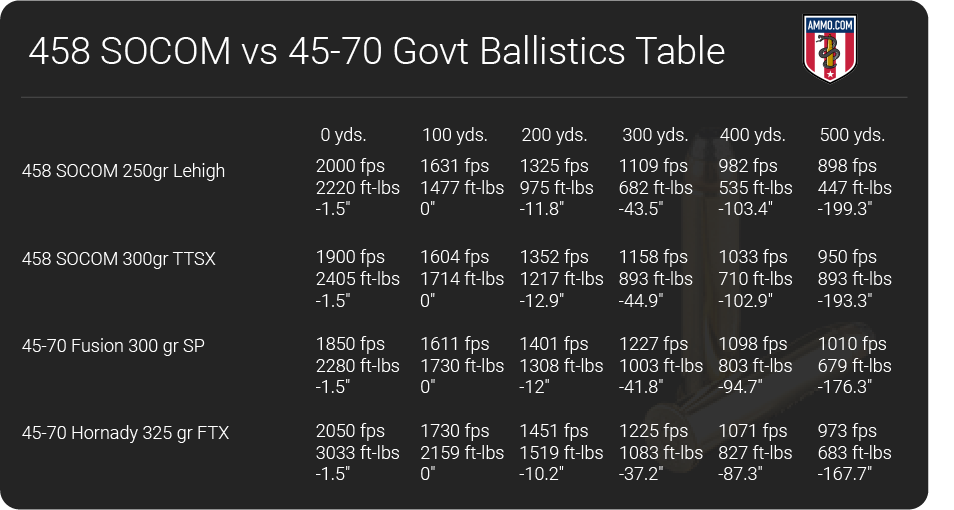
In terms of muzzle velocity, all four rounds are roughly equivalent. The highest muzzle velocity belonged to the Hornady 325 FTX for the 45-70 at 2,050 fps while the 458 SOCOM 250 gr Lehigh bullet was right behind it at 2,000 fps.
At longer distances, all four rounds approached subsonic speeds roughly around the same time. The speed of sound in feet-per-second 1,125 fps and when a bullet goes subsonic (below the speed of sound), forces like gravity and air resistance have a higher impact on a bullet’s flight.
Both 458 factory loads were right at the supersonic limit when they passed 300 yards. The 45-70 loads were able to maintain supersonic flight slightly further but were well below the supersonic limit at 400 yards.
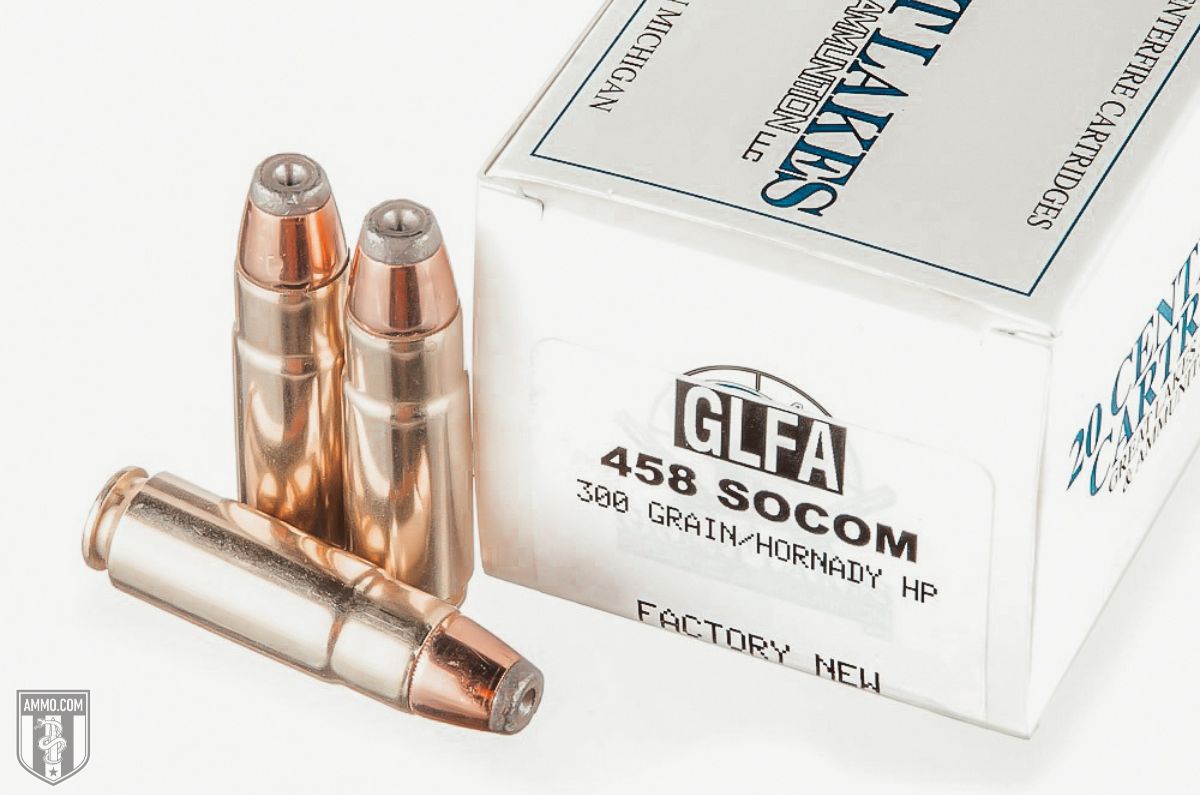
In terms of muzzle energy, the 45-70 will generally have more kinetic energy with modern loads than the 458 SOCOM. The Hornady LEVERevolution 325 Grain FTX load had the highest muzzle energy measured at 3,033 ft-lbs followed by the 300 gr Barnes TTSX load for the 458 at 2,405 ft-lbs.
It’s important to note that 45-70 ballistics are highly dependent upon the load and rifle being used. Heavier magnum +p 45-70 loads from Buffalo Bore or other custom ammo manufacturers can easily exceed 3,600 ft-lbs at the muzzle while Trapdoor suitable ammo will sit comfortably around 2,400 ft-lbs.
In terms of trajectory, the 325 gr FTX 45-70 load had the flattest trajectory by a small margin, although all four loads were relatively comparable. The 325 gr FTX 45-70 load had -37” of bullet drop at 300 yards while all other factory ammo ranged between -41” and -44”.
Ballistic Coefficient and Sectional Density
Ballistic coefficient (BC) is a measure of how aerodynamic a bullet is and how well it will resist wind drift. Sectional density (SD) is a way to evaluate the penetration ability of a bullet based on its external dimensions, design, and weight.
In general, the bullets fired by the 45-70 are not very aerodynamic and therefore have lower BC values for their weight. The main issue is that the 45-70 is typically fired from lever action rifles that utilize tubular magazines where the bullets are loaded end-to-end.
Therefore, the bullets used for a lever-action rifle must either be a round or flat nose design or hollow points. If a pointed, Spitzer style bullet was used it could impact the primer of the round in front of it in the magazine. This could set off a chain reaction that could seriously damage the firearm and/or shooter.
Hornady has attempted to remedy this situation with their Hornady LEVERevolution line of bullets. These pointed bullets are safe to use in a lever gun, as the tip is made of soft polymer that should not set off a primer when loaded into a tubular magazine.
Although the 458 SOCOM can used pointed bullets that will generally be more aerodynamic, the 458 is constrained by maximum overall length requirements of the AR-15 magazine. As such, the maximum cartridge length for a 458 SOCOM is 2.26”, which also limits bullet design to shorter, fatter, less aerodynamic bullets.
Of the four factory loads selection in the previous section, the 300 gr 45-70 Federal Fusion round had the highest BC at 0.29 while the 458 250 gr Lehigh bullet had the lowest BC at 0.194.
For sectional density, the 45-70 will have a slight edge but it is unlikely hunters will be able to discern any difference between both rounds in terms of penetration.
Similar to BC, the 325 gr FTX had the highest SD at 0.221 while the 250 gr Lehigh had the lowest SD measured at 0.17.
In general, both rounds will have more than adequate penetration for whitetail, hogs, bears, and elk within their effective range.
Self-Defense/Suppressor Integration
One of the primary goals of the 458 SOCOM was to increase the lethality of the AR platform, and it does this incredibly well as it has essentially double the kinetic energy of the 223 Remington (223 Rem) at the muzzle.
The 458 was also optimized for use in a short barreled rifle (SBR), which means a barrel length under 16 inches. Furthermore, the use of suppressor with subsonic ammo will make a completely hearing safe home defense rifle.
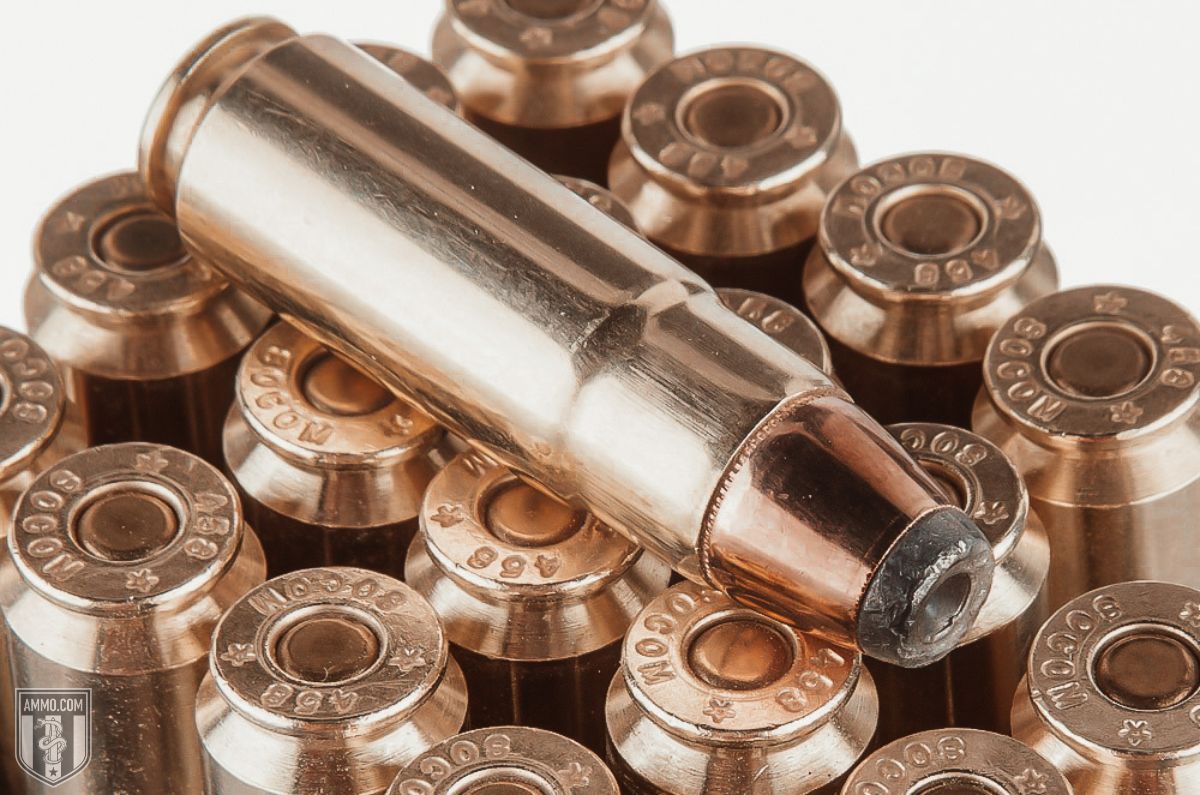
To put it bluntly, the 458 SOCOM was developed for use in close quarters battle (CQB) conditions, making it an excellent self-defense round.
This is not to say that the 45-70 can’t be used in self-defense, and many have done so to great effect. However, there is the concern of over penetration when using 45 70 high power +p magnum loads. Furthermore, the report of a 45-70 indoors would be deafening to say the least.
On the other hand, a lightweight AR-15 makes for an extremely maneuverable weapons platform. Equipped with a suppressor and LPVO (low power variable optic) or RDS (red dot sight) and you’ve got a potent home defense weapon that is hearing safe (when using subsonic rounds), offers extremely fast follow up shots, and has the kinetic energy for handling any would-be home invader.
The magazine-fed AR-15 also offers extremely fast reloads, while reloading a lever gun will take a hot minute that you might not have during a home defense situation.
Although the 45-70 is more than capable of handing any sized bad guy, the 458 SOCOM is clearly the better self-defense option thanks to its integration with the AR-15 rifle.
Hunting
Although the 458 SOCOM might be an awesome home defense option, the 45-70 cannot be beat when it comes to big game hunting.
Thanks to the massive case capacity of the 45-70, ammo manufacturers and handloaders can produce low recoil rounds for deer hunting while high power magnum loads can be used for larger game like elk, moose, and bears.
There’s not a big game animal in North America that the 45-70 hasn’t taken down, and it has proven to be a cartridge that can survive the test of time.
This isn’t to say that the 458 SOCOM can’t take down big game, as it has more than enough kinetic energy to do so. However, the slightly longer effective range of the 45-70 as well as the nostalgia factor of hunting with a lever-action rifle will keep the 45-70 around for years to come.
One area where the 458 has gained a lot of footing is in the hog hunting space, as the semi-auto capability of the AR-15 allows hunters to engage multiple targets with relative ease.
Both rounds make an excellent deer hunting option within their effective ranges. For the 458 SOCOM that is around 200 yards depending on your load and 300+ yards for the 45-70 Government.
Neither round is well suited for varmint hunting, as they are simply overkill for small game animals like woodchucks or prairie dogs. For small game I’d recommend rounds like the 223 Rem or 22-250.
Ammo and Rifle Cost/Availability
As the 45-70 has been on the market since the 1870’s, there are considerably more ammo varieties available for it.
All the major ammo manufacturers like Hornady, Federal, Winchester, Remington, Barnes, and Fiocchi have some variety of 45-70 available. Buffalo Bore in particular has multiple varieties of ammo for 45-70 Govt that cover the entire spectrum of pressures available for the beloved black powder round.
For low pressure rounds or inexpensive plinking ammo, 45 70 will cost around $2.50/round while premium hunting ammo ranges between $3 and $6/round.
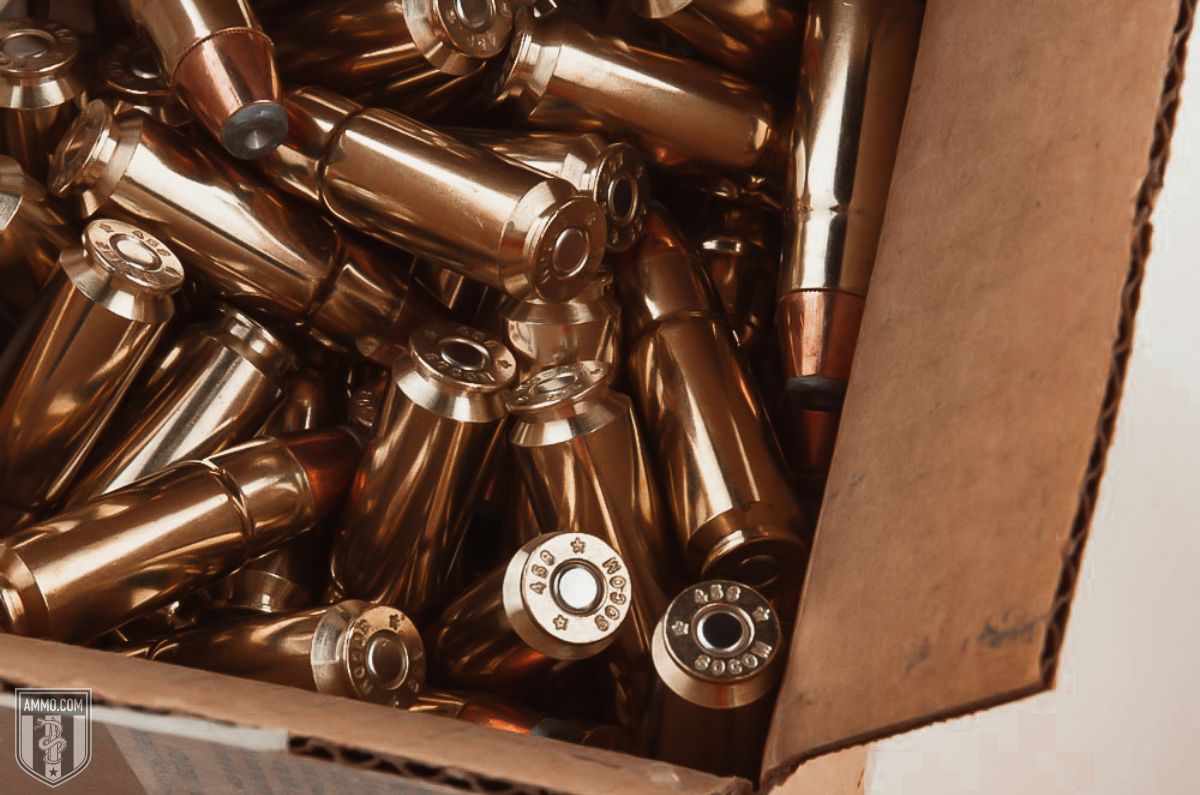
In contrast, there are only a few ammo manufacturers who offer 458 SOCOM ammo, particularly Buffalo Bore, SBR, Underwood Ammo, and Black Butterfly. The fact that the 458 is not SAAMI certified has seriously hamstrung its growth and is the reason why mainstream ammo manufactures like Hornady and Winchester do not have 458 SOCOM offerings.
In terms of price, the 458 SOCOM typically starts around $2/round for the cheap stuff and moves upwards to $5/round for premium hunting ammo.
In general, the 45-70 will have more rifle options available new from the factory or on the secondary market due to its age.
However, the types of rifles available for the 45-70 are primarily lever-action with some single shot Trapdoor Springfields still running around in the wild if you can find them.
For the 458 SOCOM, technically speaking any AR-15 could be a potential host for the cartridge, as all that is required for a conversion is a new bolt and barrel.
Sourcing a 458 SOCOM upper receiver can be a little tricky compared to other uppers like 300 Blackout or 6.5 Grendel. At the time of writing, only a few manufactures like Tromix, Radical Firearms, and Bear Creek Arsenal currently have uppers in production.
If you’re in the market for a factory produced AR-15, then Wilson Combat, Rock River Arms, and Bear Creek Arsenal are the primary manufactures offering a dedicated 458 SOCOM build.
For bolt-action rifles, the 45-70 is your only choice. However, you’ll have to settle for an older Remington Lee contract rifle, and these are getting harder and harder to find.
Rimmed cartridges are typically not used for bolt-action rifles due to the potential for the cartridge rims to become misaligned and jam in a box magazine, causing a condition known as rim lock.
Reloading
Reloading is one method shooters use to reduce their overall cost per round and increase the consistency of their ammo to sub-MOA levels. Furthermore, handloads can be tailored to your rifle to meet your specific shooting needs.
Handloaders have been tailoring 45-70 loads for over a century at this point, and this means that there is a wealth of reloading data available for the cartridge. Even though it’s not SAAMI certified, there are still plenty of reloading recipes for 458 SOCOM as well, there are just more for 45 70.
Although both rifle cartridges fire the same 0.458” diameter bullets, typically only hollow points can be fired by both cartridges due to the tubular magazine issue with the 45-70. Most bullets fired by the 45-70 are flat or round nosed while the 458 SOCOM typically fires pointed bullets.
Overall, there will be more bullet options available for the 45-70 thanks to its longstanding popularity in the big game hunting community.
For brass, the 45-70 continues its reloading dominance as there are multiple manufacturers who offer new factory brass while there are bushels of once-fired brass floating around on the secondary market.
Finding 458 SOCOM brass is more difficult in general. Although the 458 descended from the 50 AE case, normal 50 AE brass cannot be swaged into 458 SOCOM cases. This is because elongated 50 AE cases were used to create the 458 SOCOM and adding brass to a case is incredibly complex.
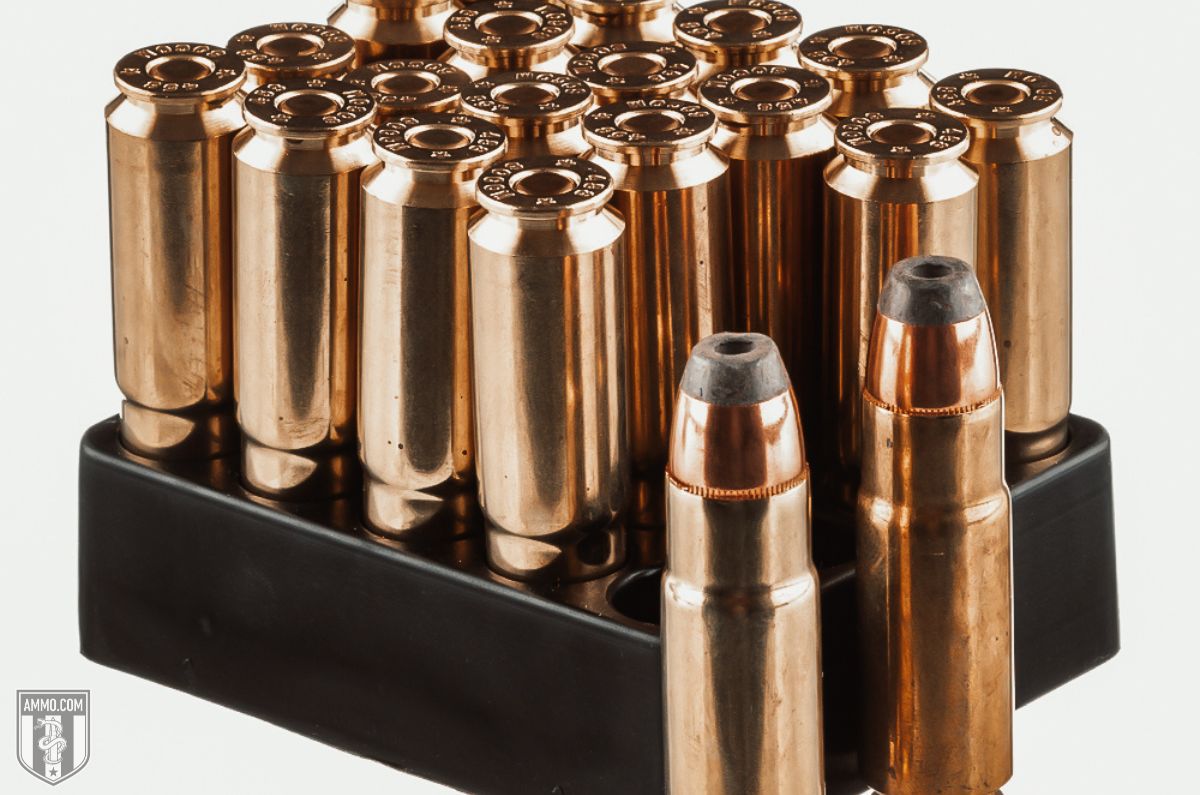
Final Shots: 45 70 vs 458 SOCOM
The 458 SOCOM and 45-70 Government are two centerfire rifle cartridges with incredibly similar ballistics but are fired from dramatically different firearms.
The 45-70 Government is one of the gold standard big game hunting cartridges that just refuses to die. “But is it better than a 45-70?” is the measuring stick used by numerous hunters, which has some merit as the 45-70 Govt has harvested every game animal North America has to offer.
In contrast, the 458 SOCOM is a relatively new addition to the shooting world that drastically increases the stopping power of the AR-15 carbine. It has become wildly popular amongst hog hunters for its brutal terminal ballistics and incredibly fast follow-up shot capability inherent to the AR platform.
Deciding between these two rounds primarily centers around what type of rifle you want. For those shooters who want the classic feel of a lever-action rifle, then the 45-70 is the obvious choice. However, if you prefer the semi-auto capabilities of the AR-15, then the 458 SOCOM has your back.
No matter which cartridge you choose, make sure you stock up on ammunition here at Ammo.com and I’ll see you on the range!
Ammo Comparisons
- .308 vs 5.56
- 6.5 Creedmoor vs .308
- .300 Blackout vs .308
- .300 Win Mag vs .308
- .243 vs .308
- .308 vs .30-06
- 7mm-08 vs .308
- .270 vs .308
- 7.62x39 vs .308
- .223 vs .308
- .338 Lapua vs .308
- .380 ACP vs 9mm
- .223 vs 5.56
- .300 Blackout vs 5.56
- 9mm vs 45 ACP
- 9mm vs 40 S&W
- .357 SIG vs 9mm
- 10mm vs 9mm
- 9mm vs 9mm Luger
- .243 vs .270
- .300 Win Mag vs .30-06
- .270 vs .30-06
- .40 vs .45
- 38 Special vs 357
- 9mm vs 40 vs 45
- 5.56 vs 7.62x39
- 338 Lapua vs .30-06
- .30-30 vs .30-06
- 300 PRC vs 338 Lapua
- .30-06 vs 7mm
- 300 Win Mag vs 338 Lapua
- 300 PRC vs 300 Win Mag
- 300 WSM vs 300 Win Mag
- 338 Win Mag vs 338 Lapua
- 12 Gauge vs 20 Gauge
- 10mm vs 357 Mag
- .30-30 vs 7.62x39
- 224 Valkyrie vs 22-250
- 17 HMR vs 22 Mag
- 7.62x39 vs .300 Blackout
- 45 ACP vs 45 Auto
- 45-70 vs 30-30
- 300 Blackout vs 223
- 357 Magnum vs 9mm
- 350 Legend vs 300 Blackout
- 224 Valkyrie vs 223
- 45 ACP vs 38 Super
- 6.5 Grendel vs .308
- 17 HMR vs 22 LR
- 10 Gauge vs 12 Gauge
- 22-250 vs 223
- 45 Colt vs 45 ACP
- 350 Legend vs 30-30
- 5.7x28 vs 223
- 5.7 vs 9mm
- 5.56 vs 5.7
- 22 vs 9mm
- Buckshot vs Birdshot
- 450 Bushmaster vs 308
- 450 Bushmaster vs 223
- Buckshot vs Slug
- 6.5 Grendel vs 5.56 vs 223
- 6mm ARC vs 6.5 Grendel
- 44 vs 45
- 458 SOCOM vs 5.56
- 357 vs 44
- 32 ACP vs 380
- 300 Win Mag vs 338 Win Mag vs 338 Lapua Mag
- 450 Bushmaster vs 458 SOCOM vs 50 Beowulf
- 6mm Creedmoor vs 6.5 Creedmoor
- TMJ vs FMJ
- 44 Special Vs 44 Magnum
- 45 90 vs 45 70
- 6.8 Western vs 6.8 SPC
- 50 Beowulf vs 50 BMG
- 26 Nosler vs 6.5 PRC
- 28 Gauge vs 410
- 6.8 SPC vs 5.56
- 6.8 SPC vs 6.5 Grendel
- 6.8 Western vs 7mm Rem Mag vs .28 Nosler
- 6.8 Western vs 6.5 Creedmoor
- 22 Hornet vs 223
- 6.8 Western vs 6.5 PRC
- .410 vs 12 Gauge
- .410 vs 20 Gauge
- 22 LR vs 22 Mag
- 6mm ARC vs 243
- 7mm-08 vs 270
- 243 vs 6.5 Creedmoor
- Nickel vs Brass Casing
- 204 Ruger vs 223
- 50 Beowulf vs 5.56
- 260 Remington vs 6.5 Creedmoor
- 6mm Remington vs 243
- 28 Nosler vs 300 PRC
- 50 Beowulf vs 50 AE
- 22 Nosler vs 22-250
- 450 Marlin vs 45-70
- 300 Win Mag vs 300 Norma
- 458 SOCOM vs 300 Blackout
- 38-55 vs 45-70
- 22 Hornet vs 22 LR
- 300 Norma vs 338 Lapua
- 338 Lapua vs 50 BMG
- 28 Nosler vs 300 Win Mag
- 28 Nosler vs 6.5 Creedmoor
- 204 vs 22-250
- 458 SOCOM vs 45 70
- 44 40 vs 45 70
- 6.8 SPC vs 6.5 Creedmoor
- 450 Bushmaster vs 30-06
- 7mm Rem Mag vs 300 Win Mag
- 30 Carbine vs 223
- 25-06 vs 30-06
- 26 Nosler vs 28 Nosler
- 16ga vs 12ga
- 30 06 vs 7.62 x54R
- 9mm Makarov vs 9mm Luger
- 350 Legend vs 223
- 30 Carbine vs 5.56
- 6.5x55 vs 6.5 Creedmoor
- 6.5 Creedmoor vs 270 vs 25-06
- M193 vs M855
- 450 Bushmaster vs 458 SOCOM
- 6.5 Grendel vs 6.5 Creedmoor
- 350 Legend vs 5.56
- .277 Fury vs 6.8 SPC
- 277 Fury vs 300 Win Mag
- 10mm vs .45 ACP
- 277 Fury vs 223
- 6.8 SPC vs 300 Blackout
- 6.5 PRC vs 6.5 Creedmoor
- 277 Fury vs 308
- 277 Fury vs 6.5 Creedmoor
- 350 Legend vs 450 Bushmaster
- 277 Fury Vs 5.56 NATO
- 10mm vs 40S&W
- 32 ACP vs 9mm
- 32 Special vs 9mm
- 8.6 Blackout vs 300 Blackout
- 30 Super Carry vs. 9mm
- 5.56 vs 9mm
- .50 Action Express vs 9mm
- 7.62x25 vs. 9mm
- 10mm vs 44 Magnum
- 300 Blackout vs 300 Win Mag
- 6.5 Grendel vs 300 Blackout
- 460 Rowland vs 10mm
- 300 RUM vs 300 PRC
- 300 Norma vs 300 PRC
- 45 GAP vs 45 ACP
- 7mm PRC vs 300 Win Mag
- 300 PRC vs 6.5 Creedmoor
- 300 PRC vs 308
- 357 SIG vs 357 Mag
- 7.62x39 vs 7.62x51
- 243 Win vs 223 Rem
- 30 Nosler vs 300 PRC
- 6.5 Creedmoor vs. 30-06 Springfield
- 450 S&W vs. 44 Magnum
- 6.5 Creedmoor vs. 300 Win Mag
- 454 Cassull vs. 45-70 Govt
- 454 Cassull vs. 44 Mag
- 7.62x54r vs. 308 Winchester
- 22 ARC vs. 223 Rem
- Subsonic vs. Supersonic Ammo
